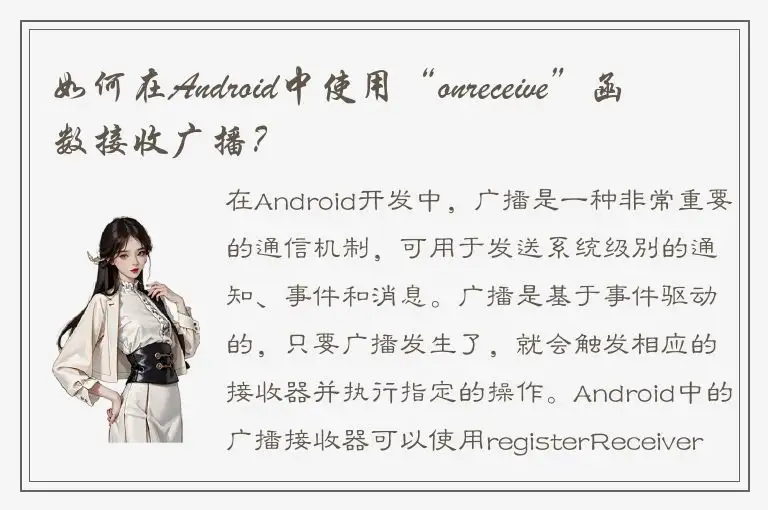在Android开发中,广播是一种非常重要的通信机制,可用于发送系统级别的通知、事件和消息。广播是基于事件驱动的,只要广播发生了,就会触发相应的接收器并执行指定的操作。

Android中的广播接收器可以使用registerReceiver()函数进行注册,通过指定一个IntentFilter过滤特定的广播类型并注册一个对应的BroadcastReceiver对象,就可以在应用程序中接收指定广播类型的消息。
当接收到广播消息时,Android会调用BroadcastReceiver的onReceive()函数,该函数会在主线程中执行,并传递一个包含接收到的广播信息的Intent对象。
本篇文章将以“”为标题,在详细介绍onReceive函数的用法和广播接收器的实现方法的基础上,为Android开发者提供一些实际开发中的建议和技巧。
一、onReceive函数介绍
onReceive函数是广播接收器的核心部分,它定义了接收并处理广播消息的逻辑。该函数在BroadcastReceiver接收到指定广播消息时自动调用,传递一个Intent对象包含有关广播信息的详细信息。
onReceive()函数的语法如下:
public abstract void onReceive(Context context, Intent intent)
在调用时,系统会传递两个参数:
Context:上下文对象,提供了访问Android应用环境中的资源和服务的方法。
Intent:Intent对象包含接收到的广播消息的详细信息,包括Action(字符串常量)、Category(字符串常量)、Data(URI)、Component等等。
在onReceive方法中,开发者可以获取Intent对象并提取相关信息,以便执行特定的操作。例如,可以使用以下代码检查是否存在特定的Extra参数:
Bundle extras = intent.getExtras();
if (extras != null && extras.containsKey("myextra")) {
String extraValue = extras.getString("myextra");
// Do something with the extraValue...
}
需要注意的是,onReceive函数在主线程中运行,因此不推荐在其中执行过于耗时的任务。如果必须执行耗时操作,建议将其放在一个独立的线程中执行,以确保不会阻塞主线程。
二、BroadcastReceiver接口介绍
BroadcastReceiver是一个Android组件,实现了接收并处理广播消息的逻辑。要使用广播接收器,必须创建一个类并继承BroadcastReceiver接口。
BroadcastReceiver接口只有一个抽象方法onReceive(),用于定义当接收到广播消息时需要执行的操作。
以下是BroadcastReceiver接口的语法:
public abstract class BroadcastReceiver {
// Called when a broadcast intent is received.
public abstract void onReceive(Context context, Intent intent);
// Control whether this BroadcastReceiver is enabled when the user is not
// present. This can be used to selectively enable/disable BroadcastReceivers
// that are used to modify behavior while in the background, such as to
// refresh network state or disk caches.
public void onReceive(Context context, Intent intent, int resultCode, String resultData,
Bundle resultExtras) {
onReceive(context, intent);
}
// ...
}
在实现BroadcastReceiver接口时,必须实现onReceive()函数,并在其中定义广播消息的处理逻辑。例如,以下代码演示了如何实现一个简单的广播接收器:
public class MyBroadcastReceiver extends BroadcastReceiver {
private static final String TAG = "MyBroadcastReceiver";
@Override
public void onReceive(Context context, Intent intent) {
Log.d(TAG, "MyBroadcastReceiver received intent: " + intent);
// Do something with the received intent...
}
}
在该例子中,MyBroadcastReceiver类继承了BroadcastReceiver接口,并实现了onReceive()函数。函数参数包括Context和Intent对象,并执行了一个简单的日志输出操作。
三、广播接收器的注册方法
在使用广播接收器之前,必须先注册广播接收器。Android提供了两种广播接收器注册方法:
在AndroidManifest.xml文件中声明广播接收器,系统会在应用程序启动时为其注册。
动态注册广播接收器,可以选择在活动中动态注册和取消注册广播接收器。
1. 在AndroidManifest.xml文件中声明广播接收器
在AndroidManifest.xml文件中声明广播接收器的语法如下:
android:exported="true" android:enabled="true">
在该代码中,声明了一个名为MyBroadcastReceiver的广播接收器,并注册了它的一个IntentFilter,用于过滤BOOT_COMPLETED广播。这样系统会在应用程序启动时自动为MyBroadcastReceiver注册。
2. 动态注册广播接收器
在活动中动态地注册和取消广播接收器的过程与在AndroidManifest.xml文件中声明广播接收器的方法大致相同,但是这种方法可以更加灵活地处理不同的广播类型,并可以灵活控制广播接收器的生命周期。
以下是在活动中动态注册广播接收器的简单示例:
public class MyActivity extends AppCompatActivity {
private MyBroadcastReceiver receiver;
@Override
protected void onCreate(Bundle savedInstanceState) {
super.onCreate(savedInstanceState);
setContentView(R.layout.activity_main);
// Create an instance of BroadcastReceiver
receiver = new MyBroadcastReceiver();
// Create an IntentFilter and add a specific action to listen for
IntentFilter filter = new IntentFilter();
filter.addAction("
// Register the receiver
registerReceiver(receiver, filter);
}
@Override
protected void onDestroy() {
super.onDestroy();
// Unregister the receiver
unregisterReceiver(receiver);
}
}
在该代码中,MyActivity动态注册了名为MyBroadcastReceiver的广播接收器,并使用IntentFilter对象筛选了指定的广播类型。在活动销毁时,MyActivity取消注册了广播接收器,以避免泄漏。
建议在动态注册广播接收器时注意以下事项:
确保在注册广播接收器后及时取消注册,在不需要监听广播时及时注销。
仅在必要时注册广播接收器,不要注册太多的广播接收器,以避免与其他应用程序或者系统产生冲突。
在接收到广播消息时尽量使用异步处理方式,以避免阻塞主线程。
从Android O开始,需要动态请求权限才能使用某些广播类型,例如android.permission.RECEIVE_SMS权限。
四、广播接收器实例分析
为了更好地理解广播接收器的实现方法,下面我们就用一个具体的实例来讲解。在接收到该广播后,将在通知栏中发出一条通知。
1. 声明广播接收器
在我们的示例中,我们将广播接收器命名为MyReceiver,并将其放置在MainActivity所在的activity包内。
package com.example.broadcastreceiver;
import android.content.BroadcastReceiver;
import android.content.Context;
import android.content.Intent;
import android.widget.Toast;
public class MyReceiver extends BroadcastReceiver {
@Override
public void onReceive(Context context, Intent intent) {
Toast.makeText(context, "Broadcast Received",Toast.LENGTH_LONG).show();
//在此处写发送通知的逻辑
}
}
在MyReceiver中,我们重写了onReceive方法,其中执行了一个简单的Toast通知操作,并在此处实现了我们想要的发送通知的逻辑。
2. 注册广播接收器
我们将在MainActivity中注册我们的广播接收器。
在MainActivity.java中,添加以下代码:
package com.example.broadcastreceiver;
import android.Manifest;
import android.app.Notification;
import android.app.NotificationManager;
import android.content.Intent;
import android.content.IntentFilter;
import android.content.pm.PackageManager;
import android.os.Build;
import android.os.Bundle;
import android.view.View;
import android.widget.Button;
import androidx.appcompat.app.AppCompatActivity;
import androidx.core.app.NotificationCompat;
import androidx.core.content.ContextCompat;
public class MainActivity extends AppCompatActivity {
private MyReceiver receiver;
@Override
protected void onCreate(Bundle savedInstanceState) {
super.onCreate(savedInstanceState);
setContentView(R.layout.activity_main);
IntentFilter filter = new IntentFilter("com.example.broadcastreceiver.NOTIFY_ACTION");
receiver = new MyReceiver();
registerReceiver(receiver, filter);
Button notifyButton = findViewById(R.id.notify_button);
notifyButton.setOnClickListener(new View.OnClickListener() {
@Override
public void onClick(View v) {
Intent notifyIntent = new Intent("com.example.broadcastreceiver.NOTIFY_ACTION");
notifyIntent.putExtra("notify_key", "Notification received");
sendBroadcast(notifyIntent);
}
});
}
@Override
protected void onDestroy() {
super.onDestroy();
unregisterReceiver(receiver);
}
}
在MainActivity中,我们首先定义了一个IntentFilter,用于筛选我们想要接收的广播类型。
然后获取到我们的广播接收器MyReceiver并进行了注册。
在布局文件当中,我们添加了一个Button,通过使用intent和sendBroadcast() 方法向broadcast Receiver发送广播。
在按钮点击事件的回调中,我们创建了一个Intent对象,设置了该Intent的Action和Extra属性,并使用sendBroadcast()方法将广播发送出去。
3. 发送广播时在通知栏中通知
在MyReceiver的onReceive()函数中,我们可以使用NotificationManager发送一个通知,然后在点击通知时打开制定的Activity,这一过程可以通过以下代码实现。
package com.example.broadcastreceiver;
import android.app.Notification;
import android.app.NotificationManager;
import android.content.Intent;
import android.widget.Toast;
import androidx.core.app.NotificationCompat;
import static android.content.Context.NOTIFICATION_SERVICE;
public class MyReceiver extends BroadcastReceiver {
@Override
public void onReceive(Context context, Intent intent) {
Toast.makeText(context, "Broadcast Received",Toast.LENGTH_LONG).show();
//获取到NotificationManager对象
NotificationManager notificationManager = (NotificationManager) context.getSystemService(NOTIFICATION_SERVICE);
int notifyID = 1;
NotificationCompat.Builder builder = new NotificationCompat.Builder(context, "notify_channel");
builder.setSmallIcon(R.drawable.ic_launcher_foreground);
builder.setContentTitle("Broadcast Notification");
builder.setContentText(intent.getStringExtra("notify_key"));
builder.setPriority(NotificationCompat.PRIORITY_DEFAULT);
Notification notification = builder.build();
notificationManager.notify(notifyID, notification);
}
}
接下来,在MainActivity中添加以下代码,创建NotificationChannel对象:
if (Build.VERSION.SDK_INT >= Build.VERSION_CODES.O) {
String channelId = "notify_channel";
CharSequence channelName = "notify_name";
int importance = NotificationManager.IMPORTANCE_DEFAULT;
NotificationChannel channel = new NotificationChannel(channelId, channelName, importance);
NotificationManager notificationManager = getSystemService(NotificationManager.class);
notificationManager.createNotificationChannel(channel);
}
至此,我们的完整示例已经完成了。
在这个示例中,我们主要展示了在onReceive()函数中发送通知的过程。当然,广播接收器还可以用于许多其他用途,例如启动后台服务、自动安装应用程序、检测连接状态变化等等。如果你想让你的应用程序在用户不使用时执行更多任务,广播接收器是必备的机制之一。
总结:
使用onReceive函数来处理广播是Android开发中的重要知识点。在编写广播接收器时,需要注意安卓版本限制,比如Android O需要申请使用某些广播类型的权限。同时,在引入广播接收器后,要注意及时取消注册,以免引起许多不必要的冲突和泄漏。
以上就是今天我所介绍的内容,对于如何应用onReceive函数接收广播,希望这篇文章对Android开发者有所提高。如果读者有任何疑问或者建议,欢迎在评论区留言,我们会及时解答你们的问题。




 QQ客服专员
QQ客服专员 电话客服专员
电话客服专员